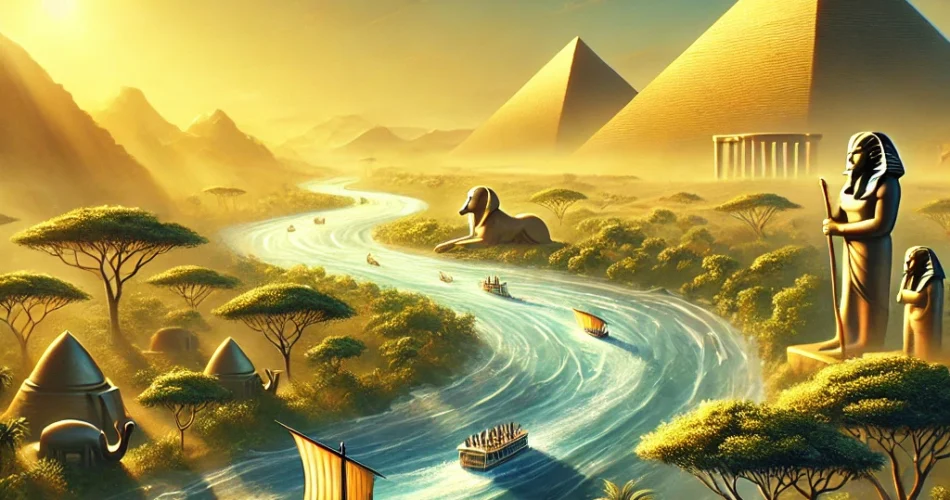The Nile was more than just a river—it was the lifeline of Ancient Egypt. It dictated the success of agriculture, trade, and the empire’s overall prosperity. Without it, civilization would have collapsed. But the Nile wasn’t a calm, predictable stream—it was a dynamic, ever-changing force of nature, requiring the Egyptians to study its patterns, adapt to its cycles, and build systems that thrived alongside it.
Just like the Nile determined the rhythm of Egyptian life, your business has its own natural flow—the customer journey. Understanding, analyzing, and optimizing this journey is the key to long-term, sustainable growth.
The Nile’s Seasonal Flooding – Preparing for Business Ebbs and Flows
Each year, the Nile experienced predictable cycles: inundation (flooding), growth, and drought. The Egyptians knew when the floods would come, how to use them to their advantage, and when to conserve resources. Instead of fighting against the river’s natural rhythm, they worked with it, developing canals, irrigation systems, and storage methods to ensure survival during dry seasons.
This is exactly how businesses should approach their seasonal fluctuations.
- E-commerce businesses often see significant spikes during Black Friday and the holiday season—just like the Nile’s annual flood.
- B2B companies may experience slower months in the summer when decision-makers are on vacation—comparable to Egypt’s dry season.
- Service-based businesses may need to prepare for demand fluctuations based on trends, economic shifts, or industry changes.
The Business Lesson: Plan for Your Business’s Seasonal Cycles
Many businesses fail to prepare for the highs and lows, leading to burnout during peak seasons and financial stress during slow periods. Like the Egyptians, you must learn to harness your flood seasons while preparing for dry spells.
✅ How to Apply the Nile’s Flow to Business Cycles:
- Study past trends and analyze data to predict seasonal demand shifts.
- Scale operations strategically—increase capacity during peak seasons and cut unnecessary expenses during slow periods.
- Develop cash flow strategies to ensure sustainability during downturns.
- Create evergreen marketing campaigns that drives leads year-round, smoothing out demand fluctuations.
By recognizing and planning for your own “Nile flood cycle,” you ensure that growth isn’t just temporary—but sustainable.
The Nile’s Branching Streams – Mapping the Customer Journey for Maximum Flow

While the Nile had a mainstream, it also branched into smaller canals and tributaries, distributing water across Egypt. These branching flows ensured the entire civilization thrived, not just those closest to the river’s core.
This perfectly mirrors how modern businesses must map and optimize their customer journey. A customer’s path to purchase is rarely a straight line. It consists of various touchpoints—ads, social media, referrals, blog posts, email sequences, and direct interactions—all working together like a network of tributaries feeding into the Nile.
The Business Lesson: Reduce Friction and Improve Customer Flow
If an Egyptian canal became blocked, entire regions suffered drought. The same happens in business when there are obstacles in the customer journey—slow response times, confusing website navigation, a lack of clear communication, or a disjointed sales funnel.
✅ How to Apply the Nile’s Flow to Customer Experience:
- Audit your customer journey from awareness to purchase—identify gaps, delays, or unnecessary friction.
- Ensure seamless transitions between marketing, sales, and fulfillment—customers should move naturally without resistance.
- Use automation and AI to streamline engagement while maintaining personalized experiences.
- Optimize your website and checkout process to make conversions as smooth as possible.
When you treat your customer journey like the branching Nile, ensuring every tributary leads customers seamlessly toward conversion, you create a business ecosystem that is both efficient and sustainable.
Adapting Like the Egyptians – Using Customer Insights to Refine Strategy
The Egyptians didn’t just observe the Nile—they tracked patterns, adjusted their farming techniques, and innovated based on discoveries. They created the first nilometers—stone structures designed to measure the water level and predict the severity of floods. This allowed them to make data-driven decisions long before the modern world coined the term.
Your business must take the same approach with customer data. If you aren’t tracking behaviors, engagement, and conversion rates, you’re operating blindly.
The Business Lesson: Use Data to Adjust and Optimize the Flow
If you ignore customer insights, you risk making poor decisions based on assumptions rather than facts.
✅ How to Apply the Nile’s Flow to Data-Driven Business Strategy:
- Track key customer metrics—bounce rates, engagement levels, conversion rates, and drop-off points.
- Run A/B tests on landing pages, emails, and marketing campaigns to see what resonates best.
- Use CRM tools to analyze customer interactions and refine sales processes.
- Implement AI-driven insights to predict trends and optimize marketing strategies.
Just like the Egyptians mastered the Nile through data collection and adaptation, businesses must embrace analytics to stay ahead.
The Nile as a Model for Sustainable Growth

The Nile wasn’t just a tool for short-term survival—it was the foundation for Egypt’s long-term success. The Egyptians used its cycles, managed its flow, and adapted to its changes, allowing them to sustain an empire for over 3,000 years.
In the same way, businesses must focus on long-term sustainability, not just quick wins. If you fail to optimize the customer journey, plan for seasonal fluctuations, and use data for continuous improvement, growth will be temporary and unstable.
Final Thought: Will Your Business Sink or Flow?
Just as Egyptians built their civilization by mastering the Nile, the most successful businesses master their customer journey by:
✅ Planning for seasonal business cycles (flood and drought)
✅ Removing friction from the customer journey (branching canals)
✅ Using customer insights to refine strategy (data analysis)
✅ Focusing on long-term sustainability rather than short-term winsThe Nile ensured Egypt’s greatness for thousands of years—what will ensure the long-term success of your business?




